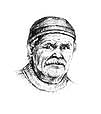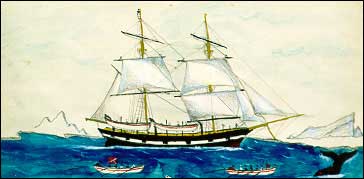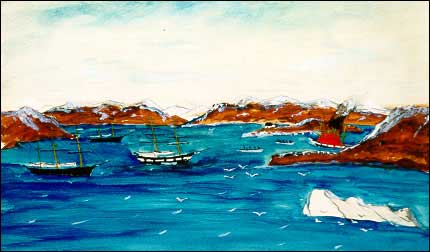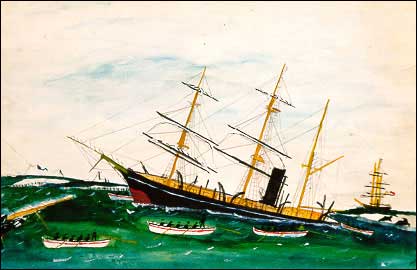The Sea
A Whaler's Tale: Extracts from the memoirs of Peterhead sailor David Cardno, 1853 - 1938
David Hawthorn Cardno's background was typical of those born into Peterhead's 19th century maritime community. What made him unique was the fact that Cardno found the will, and the time, to write his story.
The book "A Whaler's Tale", edited by Gavin Sutherland, and published by Aberdeenshire Council, is available from our publications section.
 "To
me, my story does not seem so very extraordinary, for I soon came to
accept the risks and trials as part of the day's work. To those who do
not know the Arctic, I hope it will be interesting and to those who,
like myself, hunted in those northern seas, I simply wish that they may
share with me the pleasure of looking back to the days, the ships and
the customs that now, alas, are gone." (From "A Whaler's Tale")
"To
me, my story does not seem so very extraordinary, for I soon came to
accept the risks and trials as part of the day's work. To those who do
not know the Arctic, I hope it will be interesting and to those who,
like myself, hunted in those northern seas, I simply wish that they may
share with me the pleasure of looking back to the days, the ships and
the customs that now, alas, are gone." (From "A Whaler's Tale")
The manuscript memoirs of David Hawthorn Cardno, now at the Special Collections Library, University of Aberdeen, came to my attention during research into Peterhead's famous association with the 19th century whaling industry. Cardno was born the son of a whaler in April 1853 at 24, Castle Street, Keith Inch, the island which forms the east side of Peterhead harbour, known locally as the "Queenie" and the home of the town's whale and seal "blubber" trade. Desperate to follow in the footsteps of his father and grandfather, Cardno made his first attempt to stow away aboard a whaling ship in 1863 when he was only eleven years old. By the age of thirteen he was a seasoned "Greenlandman" and, in his own words, "seen more of adventure, hardship and tragedy than most men see in a lifetime."
In 1910, after an extraordinary career as a whaler, fisherman and merchant seaman, he was appointed manager at Kekerten whaling station in Cumberland Sound, Baffin Island - originally established by Peterhead whaler Captain William Penny and now a whale spotting site, protected by the Canadian Government as a place of historical importance. For several years he lived and worked with the local Inuit community, "good natured, easy going folk," and it was during that time that he began to write his memoir in a series of old school note books. The work was finally completed in 1930, a fascinating account of the life and times of a remarkable individual.
 Cardno's first trip to the arctic whaling came at the age of 13 when he
stowed away aboard The Lord Saltoun.
Cardno's first trip to the arctic whaling came at the age of 13 when he
stowed away aboard The Lord Saltoun.
Boats from the Lord Saltoun pursue a Greenland Right Whale.
His paintings are eyewitness accounts of events that happened during his long and colourful career. The book "A Whaler's Tale" tells the story of his life at sea.

The whaler "Dublin" in flames.
This scene was witnessed by Cardno during his first trip in 1866. A fire in the blacksmith's shop in the bows of the "Dublin" destroyed the ship but Captain Davidson and his crew were taken to safety and later back home aboard other whalers.
Boats from the "Lord Saltoun" and the American whalers "Concordia" and "S.B. House" rush to assist the burning ship.

In 1882 Cardno was a harpooner aboard the "Jan Mayan" when the ice broke her stern causing a slow but unstoppable intake of water.
"And so we came to say farewell to the Jan Mayen" wrote Cardno. "When I last saw the ship she was slowly settling down in the water but I am told that she did not disappear for another 19 hours. We were all shipped to Leith on a Danish steamer along with three French crews who, like us, had lost their ships in the Iceland seas."
Boats from the sinking ship "Jan Mayan" make for the "Active" while the "Polar Star" stands by.
Cardno's Obituary from the Buchan Observer, March 15th 1938
Davie Cardno Sails Home
Mr David Cardno, Peterhead, one of the last and best known of our whalermen,
died at the home of a relative in Aberdeen last week at the age of eighty-four.
He made his first voyage to the Arctic as a boy seventy-three years ago
by stowing away aboard one of the local fleet of whalers, and for over
forty years engaged in the whaling and sealing expeditions to Baffin Land
and other parts of the frozen north.
He sailed on many of the noted whaling ships including the Windward, Jan
Mayen, Xanthus, Lord Saltoun, Polar Star and Eric, and he was a noted harpooner.
In 1914 he went to the Cumberland Gulf to take charge of a whaling station,
living alone among the Eskimos. The vessel which went out to relieve him
in 1915 was wrecked and it was not until April 1916 that he learned that
Britain and Germany were at war. He was finally taken home in June 1917
after three years alone in the Arctic.
Active and alert in his latter years, Mr Cardno had a great fund of anecdotes
about his whaling adventures and these were a source of delight to his
many friends.

